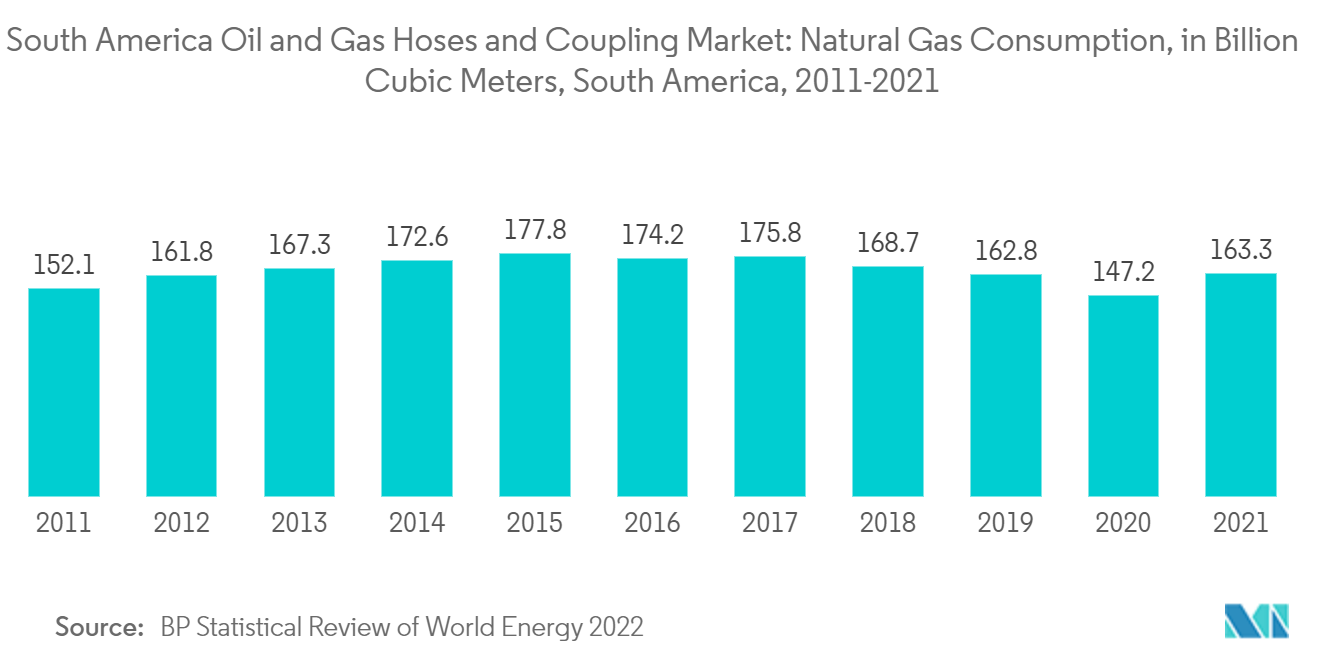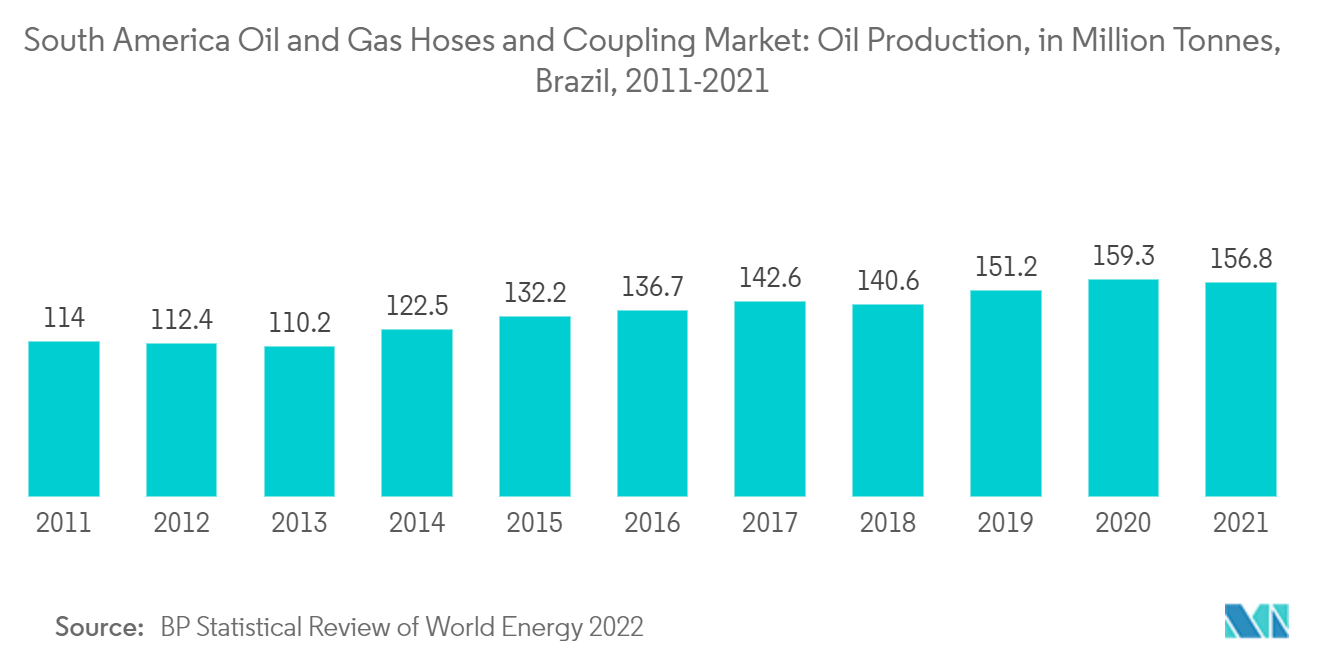Market Trends of South America Oil And Gas Hoses And Coupling Industry
Midstream is Expected to Become a Significant Segment
- The midstream sector involves transporting and storing crude oil and natural gas extracted. It includes infrastructure such as crude oil and natural gas pipelines, gas treatment plants, natural gas liquefaction plants, and liquefied gas and regasification storage.
- It is common for mid-stream oil and gas hoses to be used for safe and effective fuel delivery on floating production storage and offloading vessels, road and rail tankers, and FPSOs. In addition to handling crude oil delivered to refineries and finished oil delivered to petrol service stations, they are also designed to serve as dispensing hoses to transfer fuel from garage forecourt dispensers to vehicles.
- The world traditionally depended on oil for its primary energy needs. However, the growing concern over emissions increased natural gas consumption in the past few years. It resulted in heavy investment in natural gas processing plants. According to the bp Statistical Review of World Energy, South America's natural gas consumption in 2021 is 163.3 billion cubic meters.
- According to the Argentine Investment and International Trade Agency's - Investing in Argentina Oil & Gas Report (April 2020), the country include around USD 3 billion worth of 5 MTPA LNG export facility under its short-term project plan (2024-2025). It also includes around USD 1.5 billion worth of 2 MTPA LNG export facilities under its medium-term project plan (2026-2027).
- In September 2022, YPF and Petronas signed an agreement to collaborate on an integrated LNG project and clean energy solutions. It is to study the potential for an integrated liquefied natural gas export project in Argentina.
- In June 2022, The Colombian government relaunched a USD 700 million tender for constructing a proposed liquefied natural gas import terminal after failing to attract offers last year due to a lack of interest. According to the country's Mining & Energy Planning Unit (UPME), Colombia is looking for a contractor to build, own and operate an LNG regasification facility in the Pacific seaport city of Buenaventura.
- Because of these factors, the ongoing investments and developments in the midstream sector among the different countries in the region are expected to dominate the market during the forecast period.

Brazil to Dominate the Market
- As of 2021, Brazil is the major country in South America regarding oil & gas spending. The country's offshore pre-salt oil fields pumped around 50% of the total oil output, and this share increased to approximately 75% by the end of 2020. The increasing production and dependency on offshore oil & gas fields can be attributed to steadily decreasing production expenses due to improved drilling technology, growing expertise in the offshore oil & gas industry, and increased infrastructure.
- As of June 2022, around seven active rigs are operating in the offshore areas and three active rigs in the onshore regions of the country. As of 2021, floating assets such as Floating Production Storage and Offloading (FPSO), Drillships, semi-submersibles, and Floating Storage and Offloading (FSO) accounted for more than 80% of the active offshore platforms in the country. It, in turn, indicates the dominance of offshore floating assets in Brazil's upstream oil & gas industry.
- Brazil is expected to play a significant role in the offshore oil and gas industry's recovery from a tumultuous 2021, especially in the floating production market. The country is expected to deploy around 18 FPSOs by 2025.
- In May 2022, Singapore's Keppel Shipyard submitted the best bids in a Petrobras tender for the engineering, procurement, and construction (EPC) contracts for two FPSOs planned for Brazil's Buzios field. Keppel offered USD 2.98 billion each in lot A and lot B, beating the proposals of Sembcorp Marine, which offered USD 3.66 billion and USD 3.73 billion. Four other prospective bidders declined to submit proposals. Moreover, the FPSOs involved are P-80 and P-82, scheduled to begin operations in 2026 in the Santos basin pre-salt asset.
- Petrobras plans to invest around USD 68 billion from 2022 to 2026. Of this total investment, 84% is allocated to oil and natural gas exploration and production (E&P). Of the total E&P CAPEX (USD 57 billion), around 67% will be given to pre-salt assets. It indicates that the upstream oil & gas sector, especially Brazil's offshore oil & gas assets, is expected to witness significant investment during the forecast period.
- Therefore, factors such as plans to develop offshore oil and gas blocks, particularly in the pre-salt basins, are expected to drive the oil and gas hoses and couplings market in the upstream segment of Brazil during the forecast period.
- In addition to the demand from the country's upstream segment, the midstream in Brazil is expected to drive the market further during the forecast period owing to the upcoming pipeline and LNG projects in the country. As of 2020, more than 75% of the pipeline infrastructure in the country is located onshore, and the remaining pipeline infrastructure connects the floating regasification terminals and offshore oil & gas platforms operating in Brazil.
- As of 2021, Brazil contains 17 refineries, of which the state-owned oil & gas company operates 98% of the country's total refining capacity - Petrobras. Most of the refineries are located near demand centres on the country's coast. As part of its Strategic Plan (2021-2025), Petrobras announced to divest 8 of its 12 existing refineries and sell its remaining stakes in the midstream and fuels distribution sectors by 2022. This move, initiated by Brazil's Mines & Energy Ministry, aims to effectively facilitate the sector's ability to transition to an open and competitive downstream sector.
- According to a bp statistical review of world energy, the oil production in Brazil was 156.8 million tonnes in 2021, an increase of 37.54% over 114.0 million tonnes in 2011.
- The abovementioned factors are expected to drive the demand for oil and gas hoses and couplings over the study period.


